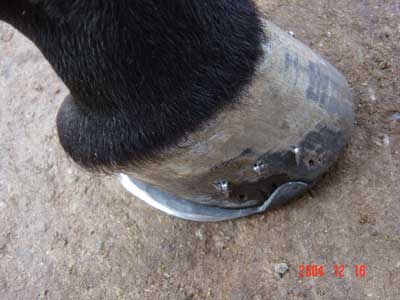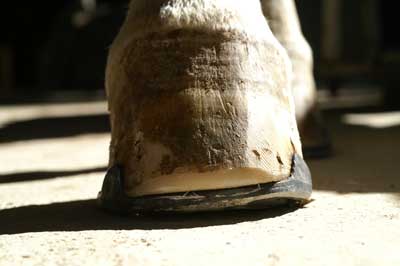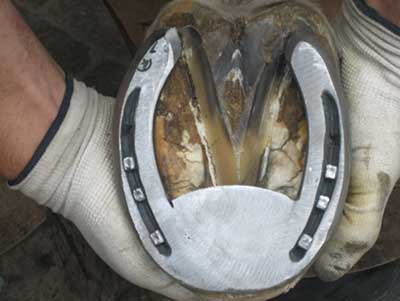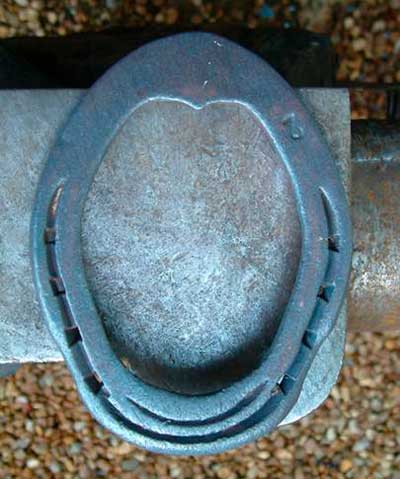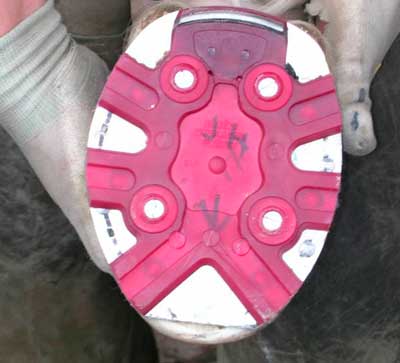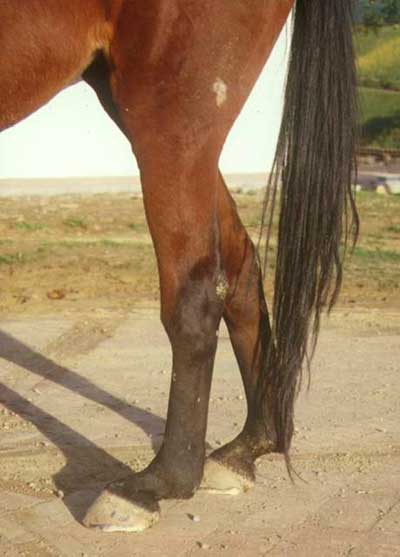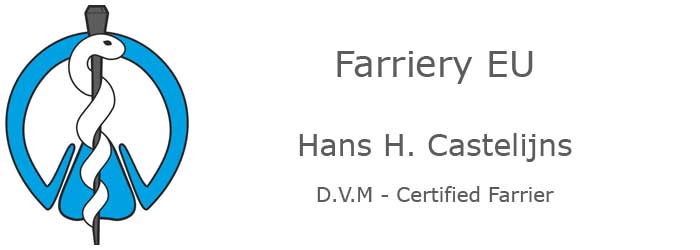
Shoeing the hind limb for performance and therapy. |
|
||||||||||||||||||||||||||||||
Introduction: |
|||||||||||||||||||||||||||||||
Normal Biomechanics of the equine hind limb is quite different from the fore limb. Hilary Clayton has compared the horse’s front limb to a weight supporting “elephant like” limb, the hind limb to a propulsive “cat-like” limb. Faulty conformation of the hind limb , as of the fore limb can only be corrected during the fast growth phase of the foal. The knowledge of growth plate closure times is essential, with as general rules that angular deviations around the fetlock should be addressed within the first three months of the foal’s life and that varus deviations are more necessary and more difficult to treat, as growth and increase in weight tend to make them worse.(fig.1) A good example, which illustrates this point is the frequently encountered “wind swept” conformation of new born foals. The hardest limb to correct is almost always the varus one, so an early lateral extension on this limb is of the utmost importance.(fig.2) |
|||||||||||||||||||||||||||||||
Performance: |
|||||||||||||||||||||||||||||||
In the adult horse, performance enhancing shoeing has to be approached carefully, taking discipline, ground/arena quality and penetrability and individual conformation in to account. Interference involving hint limbs is an important issue in performance and injury prevention, especially in some high-speed disciplines like harness racing. An invaluable , modern, tool in the analysis of the exact mechanisms of interference , is the use of high-speed cameras, the author preferring a 300 frame per second setting. (the human eye has a frequency of 50Hz ). |
|||||||||||||||||||||||||||||||
Two examples of frequently encountered interference involving hind limbs, may illustrate the importance of careful motion analysis:
|
|||||||||||||||||||||||||||||||
Tools and means |
|||||||||||||||||||||||||||||||
The author has adopted a fairly uniform trimming protocol for both front and hind feet, based on the philosophy of leaving what belongs to the foot and trimming away what has grown in excess. In more scientific terms this means trimming to a uniform sole thickness level at the bottom of the hoof; That is , trimming away only the exfoliated horn of the sole and the hoof wall which protrudes from this level. The underpinning of this trimming method has been researched by Michael Savoldi and more recently by Michael.E.Miller.(fig.4, courtesy M. Savoldi) Hoof distortion, when present, is addressed by removing flares and realigning bulb heights when necessary. This implies that the main means for both performance enhancing and therapeutic shoeing , do not involve leaving the hoof asymmetric in height, either lateral to medial or toe to heels, but in modifying shoe shape, placement and its break-over features on the normally trimmed hoof. These are essentially: Break-over enhancement , like rockered or rolled toes, heals or lateral or medial branches.(fig.6) Other tools in the box of therapeutic farriery include the different weights of different shoes e.g. alloy shoes versus steel and shock absorbing and even flexible shoeing materials. In some performance sports, like show jumping and polo, improved grip through shoe design (concave shoes) or stud use is also important. |
|||||||||||||||||||||||||||||||
Lameness |
|||||||||||||||||||||||||||||||
Lameness of the hind limb is clinically evaluated in movement by observing foot placement, hip hike, the stride’s length, its cranial and caudal phases and fetlock descent. Subtle differences in movement between hind limbs are often on the border of being a conformation/performance issue versus a true lameness one (especially in the dressage world!). Hind limbs are different from front limbs , both anatomically and functionally, even in the pes, below the hock. The hoof and distal phalanx shape are less rounded with a more pointed toe. The extendibility of its MIO III or suspensory ligament (SL) is probably larger, with a narrower channel between the accessory metatarsal bones in which its proximal part runs. Innervation is different. The superficial digital flexor tendon (SDFT) does not originate from contractible muscle bellies. Causes of hind limb lameness in the lower limb are also quite differently distributed. Hoof diseases - canker, cheratomas, quarter and toe cracks, onicomycosis, abscesses, penetrating wounds- are however fairly similar in frequency and treatment. Navicular disease is rare. The hind limb seems to suffer less from distal interphalangeal joint (DIP) disease, including collateral ligament desmitis. Arthrosis of the proximal interphalangeal (PIP) joint has a better prognosis. Distal phalanx (DP) fractures are perhaps as, or more frequent than in front limbs, due to kicking against solid objects. Plantar hoof pain and plantar process osteitis and sole bruising at the seat of corn is encountered in horses with negative plantar angles of the DP. This condition is fairly frequent, probably due to under treatment of flexor flaccidity of the hinds in new born foals. Tendonitis of the DDFT and the SDFT are often the consequence of external trauma, like wire or sheet metal cuts, as is the case for the digital extensor tendon, which may also suffer from blunt trauma in certain sports. |
|||||||||||||||||||||||||||||||
Suspensory Ligament Desmitis (SLD) |
|||||||||||||||||||||||||||||||
The incidence of SLD , especially of the origin but also of the branches, seems to become higher in sport horses , due to the stiffer modern riding arenas. It is something of a professional disease in dressage, Icelandic and standard bred horses. Prognosis for hind limb SLD is poorer than for front limb SLD. Shoeing for hind limb SLD is controversial. The underlying biomechanics are as follows, according to Jean Marie Denoix: DP orientation in the sagittal plane influences DDFT tension, which in turn influences SDFT and SL loading- the tighter the deep, the less load on the superficial and the suspensory in their role to hold the fetlock up. Thus, by prescribing a wide web toe- narrow heeled shoe during rehab on penetrable ground, the increased ground reaction force in the toe area prevents the toe from digging in to the ground , with the extended Dip joint maintaining a tighter DDFT, limiting hyper-extension of the fetlock.(fig.7, courtesy L. Entwistle) Other practitioners swear by egg-bar shoes for Hind limb SLD. On biomechanical grounds this would seem to be counterproductive, as the bar behind the heels increases ground reaction force in the caudal area ,promoting toe penetration on penetrable ground and therefore increased fetlock extension in the mid stance phase. A theoretical explanation of the benefit of the rounded bar at the heels could be a more harmonious, latero-medial landing phase. This could benefit even high SL lesions, as the medial fibers of the SL at its proximal origin cross over distally to form the lateral branch and vice-versa. Denis Leveillard has developed the “ diplomatic” SLD shoe for hind limbs, which features a wide web at the toe and a short- rounded-bar, which protrudes less caudally than a regular egg-bar.(fig.8, courtesy D. Leveillard) Francis Desbrosse advises a slight bending upwards of the heels of the shoe, so called heel rockering, in horses with strong heeled feet. The benefits are not only less ground reaction force at the heels, but also a lessening of angular velocity of the heel-toe slap on landing at speed. Suspensory ligament branch desmitis can be treated with wide toe-single wide branch shoes, the wider branch corresponding to the side of the injured branch (Denoix). Alternatively, especially on harness racing horses, going on relatively un penetrable ground surfaces, Desbrosse proposes the shock absorbing PG shoe with its short latero-medial leaver arms.(fig.9) Light weight alloy shoes are certainly use full in the treatment of SLD and SDFT tendonitis, as they reduce the whip lash like effect of the tendons and ligaments on protraction in the flight phase of the lower limb. This can be even more important with shoes which become heavier by supplying them with wider webs . Many horses however wear aluminum shoes on their hind feet strongly at the toes, therefore increasing toe penetration and consequently fetlock extension at the end of their shoeing period. Shock absorbing shoes tend to diminish both fetlock joint and digital synovial sheath ectasia (wind galls). |
|||||||||||||||||||||||||||||||
Suspensory breakdown |
|||||||||||||||||||||||||||||||
A high degree of hyper extension of the fetlock together with a straightening of the hock is often, but not exclusively, observed in older brood mares. This condition usually goes together with a lateral slipping- and distension- of the SDFT of the point of the hock.(fig.10) The hyper extended fetlock is held up by the two remaining structures, the DDFT and the overstretched and often extremely painful SL. The lateral and medial flexor muscles of the phalanxes contract to increase the tension on the DDFT, causing the toe to dig in to the ground and to wear excessively. These horses undoubtedly benefit from a wider surface of the shoe at the toe, placed in line with the original toe wall if this one has been worn back. It is also important to trim the heels of these feet well down to the natural sole depth. In extreme cases or in cases with traumatic rupture of one or more of the two flexor tendons and or of the SL, it may be necessary to apply a fetlock support shoe with a padded rigid spoon upholding the fetlock and the pastern. These orthosomas on the hind limbs should always be made adjustable and in at least 2 pieces with the supporting spoon to be applied to the base shoe after this one has been nailed on to the hoof, as the fetlock is in a flexed position when nailing on the shoe. If the DDFT is ruptured ,a plantar extension (fish bar shoe) is necessary as otherwise the toe of the foot will lift of the ground. |
|||||||||||||||||||||||||||||||
Bone spavin |
|||||||||||||||||||||||||||||||
Osteoarthritis of the medio-dorsal aspect of the distal inter tarsal and tarso-metatarsal joints is probably the most common form of hock disease in hard working horses, especially if they have a bow legged (varus hock) conformation. The author uses a wide lateral web shoe with a marked medial toe rocker. On penetrable ground the wider lateral branch will take up more of the ground reaction force, diminishing compression on the medial aspect of the hock on weight bearing. On break-over the rocker at the medial toe will diminish pressure on the dorso-medial aspect of the affected joints. |
|||||||||||||||||||||||||||||||
Stifle |
|||||||||||||||||||||||||||||||
The outward twist of the hock, together with an inward rotation of the foot on weight bearing which can be observed on some horses, especially at a walk is due to incongruity of the femoral condyles and or trochlear ridges of the talus. Many horses are able to perform quite well with this defect and trying to eliminate this stubbing movement, by increasing the grip of the shoe is counter indicated as it will increase torsion on the digital joints. Excessive wear on the outside toe and quarter of the shoe can become a problem and should be addressed by the use of a wider web and/or a slight rocker at this part of the shoe which will actually facilitate this movement and prolong the shoe’s durability. For arthrosis of the stifle some practitioners recommend a full rolling motion type of shoe, well set back at the toe.(fig.11) Upward fixation of the patella and in broader terms laxity of the medial patellar ligament, has been addressed in contradictory ways in different shoeing traditions. All agree on keeping short the toe, but while the Dutch will raise the outer branch with a wedge, the Germans would traditionally raise the inner branch. Rob Renieri explains the partial success of both methods with the fact that both change the tension on the medial patellar ligament through asymmetrical weight bearing at the hoof. The author favors a short, set back, rockered toe shoe with a widened lateral branch, as wedging has been shown to distort the hoof capsule. As is to be expected, the further away (proximal to) the source of lameness is from the hoof, the less demonstrable effect is obtained with shoeing modifications. A notable exception is muscle pain in the croup, which Richard Mansmann found to be directly related to toe length ( the longer the toes, the more pain). It can perhaps be stated that proximal causes of pain on weight bearing in the mid-stance phase, like for example sacro-iliac pain, have less of a shoeing solution than sources of pain during propulsion, where facilitating break-over may be helpful. In this context it should be noted that no matter how well executed a therapeutic or performance shoeing job is, it will grow forward and downward, increasing dorsal and latero-medial leaver arms, if left on for too long. Short shoeing intervals are a must in performance and therapy. A final word of caution on the prevention of weight bearing laminitis. It is the authors conviction that horses can cope even less with a single hind leg bearing weight for an extended period of time, than with a single front limb. This may be due to the horse’s natural attitude at rest, of periodic weight shifting between hind limbs. The severity and speed of onset of hind limb weight bearing founder, can quite literally send a horse to its end. This is especially sad in those cases where the original, contralateral limb’s lesion, might have had a decent prognosis. Getting the originally injured limb to bear weight as soon as possible and protective measures for the weight bearing foot, like caudal support or roller motion type shoes, are of paramount importance. |
|||||||||||||||||||||||||||||||
Selected bibliography: |
|||||||||||||||||||||||||||||||
Hoefverzorging en hoefbeslag, W.A. Hermans, Uitgeverij Terra Zutphen, 1984. Tratado de las Enfermedades del Pie del Caballo, A. Pires, C.H. Lightowler, Editorial Hemisferio Sur, 1991. Notes de Marechalerie, J.M. Denoix, J.L. Brochet, D. Houliez, Unité Clinique Equine-CIRALE, Ecole Nationale Vétérinaire d’Alfort. Farriery- Foal to Race Horse, S. Curtis, Newmarket Farriery Consultancy, 1999. Equine Locomotion, W. Back, H. Clayton, WB Saunders, 2001. Shoeing and balancing the Trotter, C.A. McLellan, Lessiter Publications, Inc. 2001. Hoof Problems, R. van Nassau, Kenilworth Press, 2007. The Mirage of the Natural Foot, M.E.Miller, 2010. Therapeutic Farriery, Veterinary clinics of North America, Volume 28, number 2, August 2012. |
|||||||||||||||||||||||||||||||
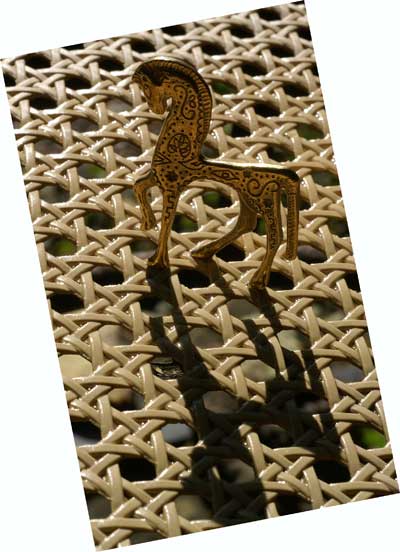 |
|||||||||||||||||||||||||||||||




